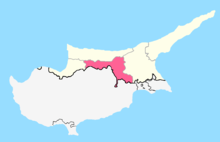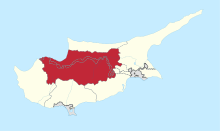Kythrea
| Kythrea | |
|---|---|
 Kythrea | |
| Coordinates: 35°15′N 33°29′E / 35.250°N 33.483°ECoordinates: 35°15′N 33°29′E / 35.250°N 33.483°E | |
| Country |
|
| • District | Nicosia District |
| Country (controlled by) |
|
| • District | Lefkoşa District |
| Government | |
| • Mayor | Osman Işısal (CTP) |
| Population (2011)[1][2] | |
| • Total | 3,284 |
| • Municipality | 11,895 |
| Website | Turkish Cypriot municipality |
Kythrea (Greek: Κυθρέα or Κυθραία; Turkish: Değirmenlik) is a small town in Cyprus, 10 km northeast of Nicosia. Kythrea is under the de facto control of Northern Cyprus.
History
Kythrea is situated near the ancient city-kingdom of Chytroi, which was founded by Chytros, grandson of the Athenian King Akamas. According to one tradition, the name Kythrea derives from Chytroi (Χύτροι > *Χυτρέα > Κυθρέα). According to another tradition, it derives from the name of the Greek Ionian island Kythera, from where millstones were transferred to Kythrea's watermills. The small town was watered for millennia by the Kefalovrysos spring; however, shortly after the 1974 Turkish invasion, the water stopped flowing. Other forms of the name include Chytri, Cythraia, Cythereia, Cythroi, Chytrides,[3] Chytros and Chytria.[4]
With the spread of Christianity in Cyprus, Chytroi became a bishopric. The first bishop, whose name is known is Pappus, is mentioned in the Life of Epiphanius of Salamis as having been bishop for 58 years of the "miserable town of Chytria", and as having died a martyr at some unspecified date, which must have been under either the pagan emperors Licinius or Maximinus II, or the Arian Constantius II. The acts of the Council of Chalcedon (451) show that Bishop Photinus was represented there by his deacon Dionysius, and those of the Second Council of Nicaea in 767 that Bishop Spyridon attended in person.[4][5]
Contemporary documents are lacking concerning Demetrianus, whom Henri Grégoire described as perhaps the most obscure of the local saints of Cyprus. The medieval Leontios Machairas is the earliest writer to make even a brief mention of his name. According to the oldest Life of Demetrianos, published in the 18th century, he became bishop in around 885, was captured by Arabs and taken to Egypt with many of his faithful, but by his prayers obtained the liberation of all.[6]
No longer a residential bishopric, Chytri is today listed by the Catholic Church as a titular see.[7]
Kythrea is a remarkable archaeological area. One outstanding statue discovered in the area is the bronze statue of Roman Emperor Sepimius Severus, exhibited in the archaeological museum of Nicosia. The Kythrea municipality was established in 1915.[8]
Administration
The town is administered by the Turkish Cypriot Municipality of Değirmenlik.[9] The current mayor is Osman Işısal from the Republican Turkish Party (CTP).[10]
Displaced inhabitants of Kythrea, now located in Nicosia and elsewhere, maintain a municipality in exile. It shares premises with the similarly-displaced municipality of Lapithos at 37 Ammochostou Street, Nicosia.
Demographics
After its Greek Cypriot inhabitants were displaced in August 1974, the town was repopulated by displaced Turkish Cypriots. The main origin of the Turkish Cypriots that settled in the town is the village of Alaminos, but inhabitants of many other villages were also relocated here. There are some Turkish people that have settled in the town as well, mostly hailing from the Mersin Province.[11]
Culture
Değirmenlik Association of Culture and Arts in a non-governmental organization that is active in the town, and it annually organizes the Festival of Culture and Arts since 2009. The members of the association participate in festivals abroad. The Municipality of Değirmenlik has a folklore group that is open to children.[12]
International relations
Twin towns – sister cities
Kythrea is twinned with:
References
- ↑ "KKTC 2011 Nüfus ve Konut Sayımı" [TRNC 2011 Population and Housing Census] (in Turkish). TRNC State Planning Organization. 6 August 2013.
- ↑ "K.K.T.C. POSTA DAİRESİ" [TRNC Postal Department] (in Turkish). Retrieved 9 November 2014.
- ↑ Sophrone Pétridès, "Chytri" in Catholic Encyclopedia (New York 1908)
- ↑ 4.0 4.1 Michel Lequien, Oriens christianus in quatuor Patriarchatus digestus, Paris 1740, Vol. II, coll. 1067-1070
- ↑ Raymond Janin, v. Chytri, in Dictionnaire d'Histoire et de Géographie ecclésiastiques, vol. XII, Paris 1953, col. 820
- ↑ Henri Grégoire, Saint Démétrianos, évêque de Chytri, in Byzantinische Zeitschrift 16 (1907), pp. 204–240
- ↑ Annuario Pontificio 2013 (Libreria Editrice Vaticana 2013 ISBN 978-88-209-9070-1), p. 868
- ↑ N. G. L. Hammond, C. J. Gadd, I. E. S. Edwards (1970). The Cambridge ancient history (3 ed.). Cambridge University Press. p. 540. ISBN 0-521-07051-1.
- ↑ Eastern Mesarya Area (EU Aid Programme for Turkish Cypriot Community) Retrieved on 30 December 2014.
- ↑ Değirmenlik'te Osman Işısal ipi göğüsledi (Kıbrıs Postası) retrieved on 30 December 2014.
- ↑ Kythrea (Prio Cyprus Centre) Retrieved on 30 December 2014.
- ↑ Kıbrıs kültürünün yaşatılması önemli (Kıbrıs) Retrieved on 30 December 2014.
- ↑ "Gebze - Twin Towns". © Gebze-City.sk. Retrieved 2013-10-19.
| ||||||||||||||||||||||
| ||||||||||||||||||||||||||
| ||||||||

